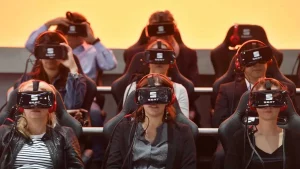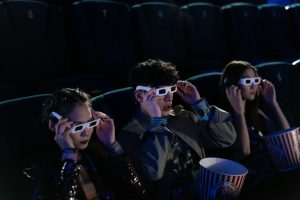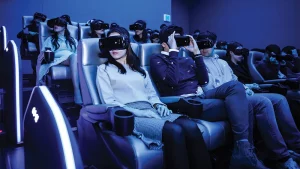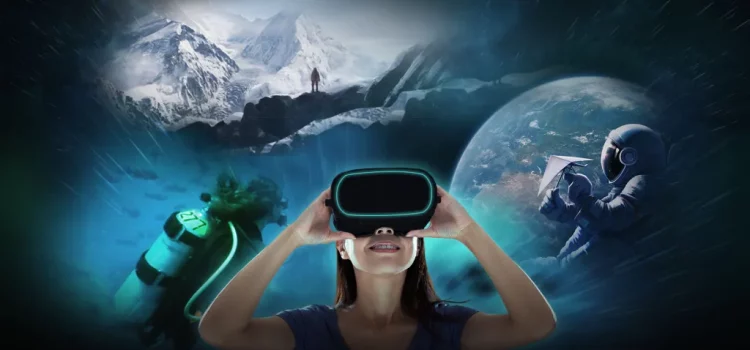
Introduction
Cinema has always been a dynamic and evolving medium, constantly adapting to technological advancements and changing audience preferences. From the early days of silent films to the advent of sound, color, and digital projection, the film industry has continually sought new ways to captivate audiences. As we look to the future, the next frontier in the evolution of cinema appears to be experiential and immersive theaters. This article explores the transformative potential of these cutting-edge venues and how they are poised to redefine the movie-going experience.
The Evolution of Cinema

-
Early Beginnings
The history of cinema dates back to the late 19th century when pioneers like Thomas Edison and the Lumière brothers introduced the world to moving pictures. These early films were short, silent, and often shown in makeshift venues. Despite their simplicity, they captivated audiences and laid the groundwork for the future of cinema.
-
The Golden Age
The 20th century saw the rise of Hollywood and the establishment of cinema as a major form of entertainment. The introduction of sound in the late 1920s and color in the 1930s revolutionized filmmaking and drew larger audiences to theaters. The Golden Age of Hollywood produced iconic films and stars, solidifying cinema’s place in popular culture.
-
The Digital Revolution
The late 20th and early 21st centuries brought about the digital revolution in cinema. Digital cameras, editing software, and projection systems transformed the industry, making filmmaking more accessible and cost-effective. The rise of streaming services further changed how audiences consumed films, leading to concerns about the future of traditional theaters.
The Rise of Experiential and Immersive Theaters

-
Defining Experiential and Immersive Theaters
Experiential and immersive theaters go beyond traditional movie-watching by offering audiences a multi-sensory experience. These theaters use cutting-edge technology to create an environment where viewers feel like they are part of the film. This can include advanced audio-visual systems, interactive elements, and even physical effects like motion seats and scent.
-
Technological Innovations
Several technological innovations are driving the development of experiential and immersive theaters:
- Virtual Reality (VR) and Augmented Reality (AR): VR and AR technologies allow audiences to step into the world of the film, providing a 360-degree view and interactive elements that enhance the storytelling experience.
- 4D Cinemas: These theaters incorporate motion seats, wind, water, scents, and other physical effects to create a fully immersive environment. The audience can feel every explosion, gust of wind, and splash of water, making the film experience more visceral.
- High Dynamic Range (HDR) and High Frame Rate (HFR): HDR and HFR technologies enhance the visual quality of films, providing greater detail, color accuracy, and smoother motion. This results in a more lifelike and immersive viewing experience.
- Advanced Sound Systems: Immersive audio technologies like Dolby Atmos and DTS:X create a three-dimensional soundscape, allowing audiences to hear sounds from all directions. This adds depth and realism to the film’s audio.
-
Examples of Experiential and Immersive Theaters
Several theaters around the world are leading the way in experiential and immersive cinema:
- IMAX: IMAX theaters are known for their large screens, high-resolution projection systems, and powerful sound. They provide a more immersive experience compared to traditional theaters.
- 4DX: 4DX theaters offer a multi-sensory experience with motion seats and environmental effects like wind, rain, and scents. These theaters are designed to make audiences feel like they are part of the action.
- VR Cinemas: VR cinemas use virtual reality headsets to transport audiences into the film. Viewers can look around and interact with the virtual environment, creating a fully immersive experience.
- ScreenX: ScreenX theaters feature a 270-degree projection system that extends the film onto the side walls of the theater. This creates a panoramic viewing experience that surrounds the audience.
The Impact on Filmmaking

-
New Storytelling Opportunities
The rise of experiential and immersive theaters is opening up new storytelling opportunities for filmmakers. Directors and writers can now create films that take full advantage of these technologies, crafting narratives that are more interactive and engaging. For example, VR films can allow viewers to choose their own path through the story, creating a personalized experience.
-
Challenges and Considerations
While the potential of experiential and immersive theaters is exciting, there are also challenges and considerations for filmmakers:
- Technical Complexity: Creating films for these theaters requires specialized knowledge and equipment. Filmmakers need to understand how to use VR, AR, and other technologies effectively.
- Cost: Producing immersive films can be expensive due to the need for advanced technology and special effects. This may limit the accessibility of these films to larger studios and established directors.
- Audience Adaptation: Not all audiences may be comfortable with the level of immersion offered by these theaters. Some viewers may prefer traditional cinema experiences.
The Future of Cinema

-
A New Era of Movie-Going
The future of cinema lies in creating experiences that cannot be replicated at home. Experiential and immersive theaters offer a unique value proposition by providing an environment where audiences can fully engage with the film. This has the potential to draw people back to theaters and reinvigorate the movie-going experience.
-
Integration with Other Forms of Entertainment
Experiential and immersive theaters also have the potential to integrate with other forms of entertainment, such as gaming and live performances. This can create hybrid experiences that appeal to a broader audience and offer new revenue streams for theaters.
-
The Role of Streaming Services
While experiential and immersive theaters are set to redefine the movie-going experience, streaming services will continue to play a significant role in the future of cinema. The challenge for theaters will be to offer experiences that complement, rather than compete with, the convenience of streaming.
Conclusion
The future of cinema is bright, with experiential and immersive theaters leading the way in transforming how we experience films. By leveraging cutting-edge technology and innovative storytelling techniques, these theaters are poised to create unforgettable experiences that captivate audiences. As the industry continues to evolve, the key to success will be finding the right balance between traditional and new forms of cinema, ensuring that the magic of the movies remains alive for generations to come.










